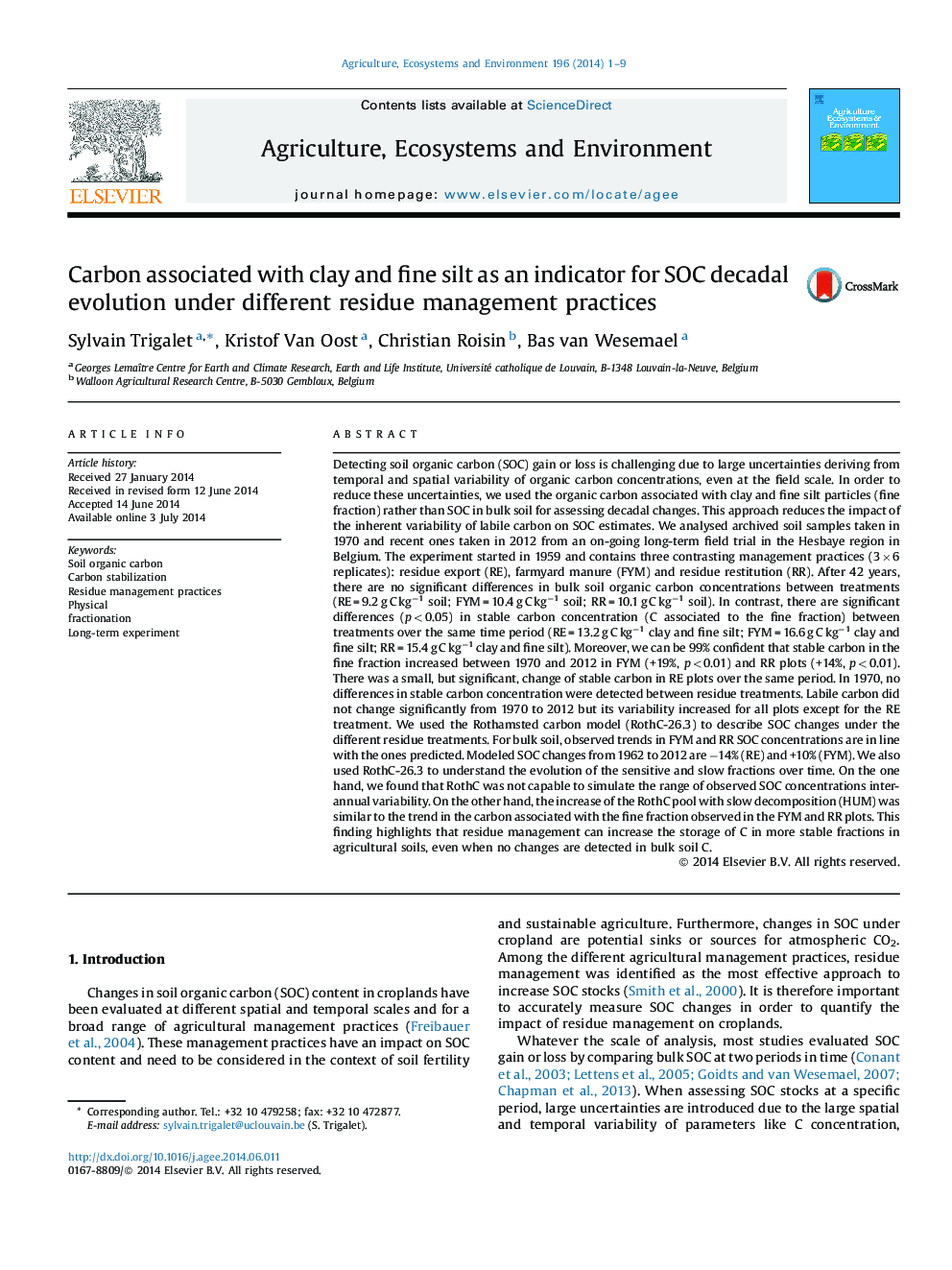| کد مقاله | کد نشریه | سال انتشار | مقاله انگلیسی | نسخه تمام متن |
|---|---|---|---|---|
| 2413987 | 1552056 | 2014 | 9 صفحه PDF | دانلود رایگان |

• No significant changes detected in bulk soil carbon and labile carbon over 42 years.
• SOC stabilization over decades for carbon associated with clay and fine silt.
• Residue management practices can increase C content of stable C pools in cropland.
• SOC in the fine fraction is a good indicator to assess C changes over decades.
Detecting soil organic carbon (SOC) gain or loss is challenging due to large uncertainties deriving from temporal and spatial variability of organic carbon concentrations, even at the field scale. In order to reduce these uncertainties, we used the organic carbon associated with clay and fine silt particles (fine fraction) rather than SOC in bulk soil for assessing decadal changes. This approach reduces the impact of the inherent variability of labile carbon on SOC estimates. We analysed archived soil samples taken in 1970 and recent ones taken in 2012 from an on-going long-term field trial in the Hesbaye region in Belgium. The experiment started in 1959 and contains three contrasting management practices (3 × 6 replicates): residue export (RE), farmyard manure (FYM) and residue restitution (RR). After 42 years, there are no significant differences in bulk soil organic carbon concentrations between treatments (RE = 9.2 g C kg−1 soil; FYM = 10.4 g C kg−1 soil; RR = 10.1 g C kg−1 soil). In contrast, there are significant differences (p < 0.05) in stable carbon concentration (C associated to the fine fraction) between treatments over the same time period (RE = 13.2 g C kg−1 clay and fine silt; FYM = 16.6 g C kg−1 clay and fine silt; RR = 15.4 g C kg−1 clay and fine silt). Moreover, we can be 99% confident that stable carbon in the fine fraction increased between 1970 and 2012 in FYM (+19%, p < 0.01) and RR plots (+14%, p < 0.01). There was a small, but significant, change of stable carbon in RE plots over the same period. In 1970, no differences in stable carbon concentration were detected between residue treatments. Labile carbon did not change significantly from 1970 to 2012 but its variability increased for all plots except for the RE treatment. We used the Rothamsted carbon model (RothC-26.3) to describe SOC changes under the different residue treatments. For bulk soil, observed trends in FYM and RR SOC concentrations are in line with the ones predicted. Modeled SOC changes from 1962 to 2012 are −14% (RE) and +10% (FYM). We also used RothC-26.3 to understand the evolution of the sensitive and slow fractions over time. On the one hand, we found that RothC was not capable to simulate the range of observed SOC concentrations inter-annual variability. On the other hand, the increase of the RothC pool with slow decomposition (HUM) was similar to the trend in the carbon associated with the fine fraction observed in the FYM and RR plots. This finding highlights that residue management can increase the storage of C in more stable fractions in agricultural soils, even when no changes are detected in bulk soil C.
Journal: Agriculture, Ecosystems & Environment - Volume 196, 15 October 2014, Pages 1–9